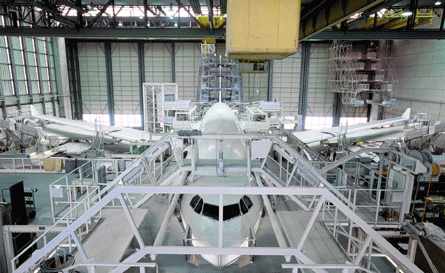Revised thinking has altered the direction of an EU-funded project aimed at delivering reductions in maintenance costs through better aircraft health management. The rethink acknowledges that the initial goals were too optimistic and narrowly defined.
Launched in March 2004 with a budget of €40 million ($56.3 million), the "technologies and techniques for new maintenance concepts" project (TATEM) was charged with delivering a 20% reduction in airline operating costs within 10 years and a 50% cut within 20 years.
It assembled 57 member companies from 12 European countries, Israel and Australia. UK engineering company Smiths Aerospace was appointed as the project's leader, and has continued to fill that role follow its acquisition by GE and rebranding as GE Aviation Systems. Other big names involved include Airbus, Air France, Alenia, BAE Systems, Eurocopter, EADS, Thales, Safran and SR Technics.
 |
|---|
© SR TechnicsMaintenance provider SR Technics is part of the TATEM project, aimed at cutting MRO costs |
"When the proposal was written we were focused on trying to reduce DOC [direct operating costs]," says TATEM project director Martin Worsfold.
"As we got into the subject we realised that, actually, our ability to do that was more limited than we thought, but in addition, that wasn't necessarily the most important thing. Availability and mission reliability were just as important."
This shift in emphasis brought a tightening of the cost focus, to zero in on maintenance-related costs (rather than direct operating costs as a whole).
The project's term, originally four years, has been extended, with the result that the final project meeting is now set for November this year.
That will be followed by a two-day event in Cheltenham, UK, in December, when the output of the project will be presented, including a cost-benefit analysis based on "physical validation of the TATEM concepts on some 40 subsystem and six system-level evaluations".
 |
|---|
© Data Systems and SolutionsTATEM aims to build on the tradition of engine health monitoring, practised for more 30 years |
"Operability" is the name the project team gives to its targeted amalgam of higher availability, reduced maintenance-related costs and increased reliability, and advances in aircraft health management are targeted as the means by which these goals can be delivered. Success requires not just sophisticated onboard sensors and off-board data management platforms, but a new philosophy of integration.
FAULT FINDING
Mike Fullington, a senior engineer at GE Aviation's Diagnostics & Prognostics Center, explains that, traditionally, the industry's "fantastic" safety record has been delivered at the expense of efficiency in maintenance and inspections. One source of inefficiency is inaccuracy in identifying root causes, which can necessitate multiple trouble-shootings to fix a single problem.
Another source is the high incidence of no-faults-found typical in built-in test equipment (BITE). It is estimated that BITE system reliability typically falls between 40 and 60%. The TATEM team has set a goal of increasing that to 90%.
Increased BITE system reliability is just one of a number of project pillars identified by Worsfold. Others include prognostics and process-oriented maintenance.
In prognostics, the goal is to develop systems that can flag problems before they become critical, dictate the action required and recommend a suitable time and place for it to be carried out.
For process-oriented maintenance, interactive multimedia tools are envisioned, allowing technicians to access the precise information required to complete a task without sifting through extraneous detail.
These tools would function in a similar way to Microsoft Office's paperclip function, providing context-related help. To further assist technicians, the TATEM team is working to develop wearable computing tools that can be brought to the aircraft, boosting "mobile maintenance" efficiency.
"We're also trying to make a more fault-tolerant aircraft," says Worsfold. "One of the problems in doing research in this field is that you're working all the way across the whole enterprise, from conceptual design through to manufacturer support and then disposal. It needs people to approach it in a different way, because they need to think about the whole enterprise in terms of what is important to the operator, what is important to the maintainer and what is important to the supply chain."
With around one-third of the global commercial fleet on operating lease, aircraft lessors have a major stake in the the TATEM project's success. Anton Tams, senior vice president of process planning and control at leasing giant GECAS, notes that a lease aircraft is typically transitioned - moved between lessees - three or four times in its life, with typical transition costs ranging between $560,000 (for a regional jet) and $4.18 million (for a widebody).
A lack of standardisation means transitioning aircraft records - often held on paper - can cost the lessor $40,000-$80,000 while attending to regulatory issues can cost $300,000-$600,000. Transitioning maintenance programmes can cost the lessee $80,000-$300,000.
Given the need for standardisation, Tams welcomes the level of international co-operation entailed in the TATEM project: "The challenge for the group is to stay focused on the big picture, but we were very pleased to be asked to participate at the ideas stage rather than at the product rollout stage, which is the usual for lessors."
The data gathered by health management systems could, he adds, be harnessed by lessors to ease transition costs. "A lot of the effort is around standardising the presentation of the materials so that we can ascertain what we're taking back, and so that the next customer and their regulatory authority can ascertain what they're getting. The more information that's available about the status of the aircraft, the better - for everybody."
EXTRACTING VALUE
Naturally there are technical and financial obstacles to overcome on the road to successful aircraft health management. "There are real technical issues understanding the physics of failure to allow you to develop prognostic systems that can tell you about the remaining useful life of a component or a system or series of systems, and there's obviously a cost associated with doing the testing that is required to build confidence in those systems," says Worsfold.
The TATEM project is focused on new-build aircraft. Whether or not new technologies in development should be retrofitted to older aircraft will depend on its type and mission, says Worsfold, who identifies a question that airline managers must address:
"Is it cheaper to buy a lower-cost aircraft and have a few extras lying around the hangar in case you have a problem in service, or to have a smaller number of very sophisticated aircraft that you can rely on or - if they start to degrade - tell you that they're degrading? There is certainly a cost-benefit analysis that needs to be done by people who buy and support these aircraft. There is no definitive answer there."
The case is clearer with engines , where condition monitoring has been practised for more than three decades, evolving to a point where operators of GE and CFM engines are offered GE's base level of diagnostics free of charge.
This apparent boon to the operators in fact fits with GE's business case: customers in the lucrative aftermarket business require guaranteed performance levels, delivery of which requires an understanding of asset condition. Increasing the number of engines monitored potentially deepens that understanding and so assists in winning maintenance contracts.
The upshot is that GE's Diagnostics & Prognostics Center - located at Evendale, Ohio - has grown its activity to the point where it now monitors 19,000 engines operated by 300 customers, gathering more than two million records a month. "There's a mountain of information to pull from," says Fullington, "and there's gold in that mountain. We have to dig."
Source: Flight International























